Hermetospheres or bottle gardens - a new trend in plant husbandry
Table of contents
- How does a bottle garden work anyway?
- Preparations
- Filling in the substrate
- Preparing the plants
- Planting and decorating the bottle garden
- Water and put the lid on
- Tips for care
- Which plant species are suitable for a hermetosphere?
How does a bottle garden work anyway?
A hermetosphere or bottle garden is its own self-contained little ecosystem that requires virtually no work. It consists of a tightly sealed bottle or jar with a stopper made of cork, plastic or glass. There is no air exchange with the environment and human intervention should be kept to a minimum. Watering is done every few months, no fertilising at all.
Such a hermetosphere is best operated without soil or peat - this has several advantages for the keeper and also for the plants.
For one thing, soil or peat tends to become compacted in waterlogged conditions, leading to rot and mould. The roots of the plants become muddy and the plants can die. In a soilless bottle garden, on the other hand, we use coarse lava granulate as a substructure and fine aquarium gravel on top, in which the plants grow. Here, nothing gets muddy or compacted, and the plants can continue to grow with healthy roots even with a little more water in the substrate. The life of a hermetosphere in which potting soil is largely dispensed with is significantly longer and the plants appear healthier.
Furthermore, potting soil contains significantly more nutrients than the lava granules and neutral gravel we use in our bottle gardens. As a result, the plants grow stronger and you have to intervene more often in the ecosystem and cut them back. In a bottle garden without potting soil, on the other hand, the plants do not grow as rapidly and you have much less work to do as a result.
All our kits come with enough substrate so you don't need to add extra potting soil.
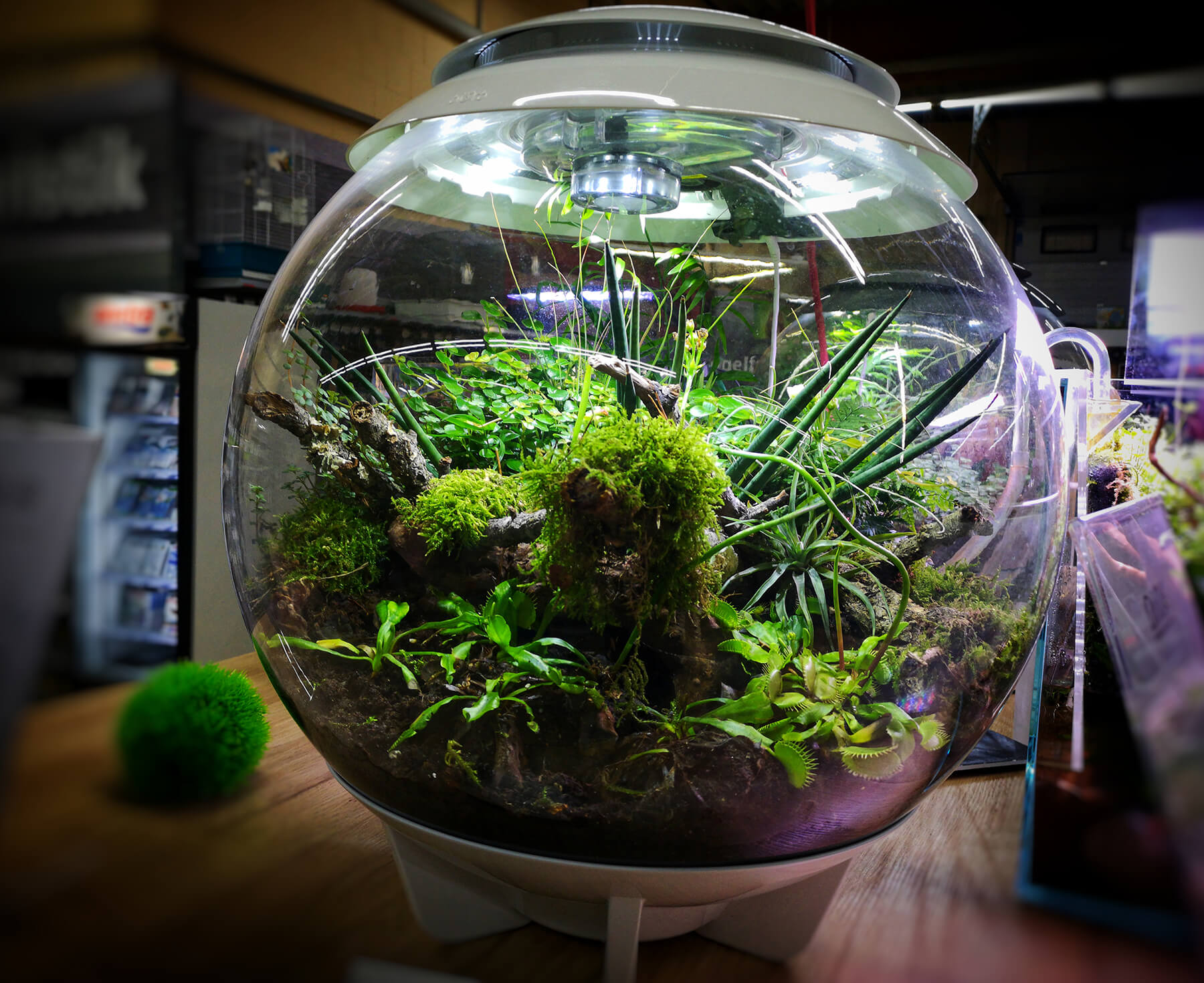
Preparations
First of all, find a good place for your hermetosphere: The planted glass should later be placed in a bright place, but not exposed to direct sunlight - this would cause the temperature in the bottle garden to rise too much and the plants would die. A place that is too cold or too warm is also not good - room temperature is sufficient for most plants in bottle gardens.
When the place has been found, the glass container made of clear, transparent glass (important because it lets light through) is first rinsed clean and dried. To set it up, it is best to place the jar on an old towel so that there is no tension caused by grains of sand or small stones that get under the bottom of the bottle when setting it up.
Jars with a wide base and large opening can be used upright as a hermetosphere because they are very suitable for planting. Bottles with narrower necks, on the other hand, can also be planted lying down - this makes the job easier, and such a planted bottle lying on its side has a very special flair, almost like a living green message in a bottle!
Larger planted bottles usually do not roll away because the substrate is heavy enough. If you want to be absolutely sure, you can build a small bottle stand out of wood in which the bottle comes to rest.
Then we lay out the necessary equipment: stones, gravel, lava granulate, plants, possibly a long planting tweezers or a long stick and an old newspaper.
We also need a sieve fine enough to rinse the stone substrates briefly under cold water to remove the abrasion from transport.
Lime-free water for watering would also be good, but soft tap water is also suitable.

Fill in the substrate
First, wash all the substrates separately in a fine-mesh sieve under running water to remove dust and debris from transport. Allow to drip off a little before continuing.
Then a layer of the coarse lava granulate is placed on the bottom. It provides stability and is also useful as a water reservoir. In addition, lava contains a small amount of nutrients and minerals that will later benefit the plants without triggering too much growth.
If you want it to be perfect, make sure to keep a little distance between the lava and the glass when filling it in. The space in between is then filled with different coloured layers of gravel or sand. This creates interesting colour patterns that contribute to the attractiveness of the bottle garden.
The substrates can be filled in much more precisely if you improvise a funnel from an old rolled-up newspaper. Normal funnels from the kitchen usually have a much too small opening and would clog.
Place a layer of finer gravel or grit over the lava. Aquarium gravel is wonderful here, and you can play with different colours and different layers. Coarser sand is also suitable.
The optimum bottom height is about 10 to 20 percent of the height of the glass. It is important not to give the plants too much space for their roots, in order to limit their growth somewhat. The soil should be about the same height throughout the glass.
What substrates are suitable for a bottle garden?
Coarse lava chippings are perfect as a substrate. It stores water and its coarse structure ensures that the substrate does not sit together and become anaerobic. In addition, lava contains a small amount of minerals that benefit the plants.
Neutral aquarium gravel or aquarium sand are the perfect substrate for fine work in the bottle garden. Coarse quartz sand or untreated play sand are also very suitable. The grain size should be larger than 2 mm - finer sand is only suitable for shaping the area around the glass. It would compact too quickly as a planting substrate.
Substrates with a high lime content such as marble chippings or heavily fertilised soil such as plant soil are not ideal.
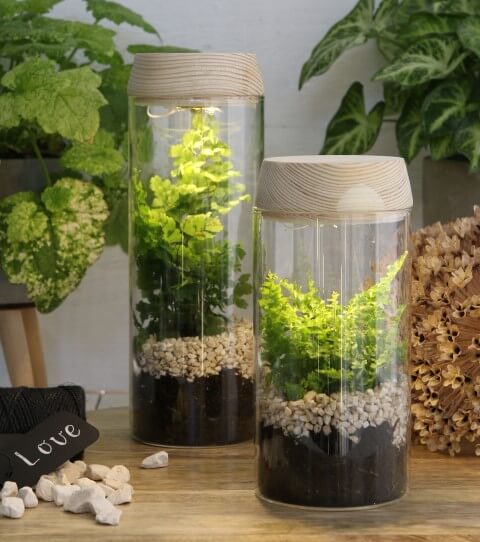
Prepare the plants
When the plants for your bottle garden have arrived in a pot with soil, first remove the root ball from the pot and shake off excess soil. Then shorten the roots by about half. This will give them a growth impulse and they will branch out more quickly. The plant will grow better this way. Leave some soil on the roots, which will provide the plant with the necessary nutrients in the hermetosphere.
Cut off shoots that have grown too high with sharp scissors. You can then stick these additionally as cuttings into the gravel or sand in your bottle garden.
If you want to use emersed aquarium plants, remove them from the pot and free the roots as best you can from the rock wool in which the plants were grown. If you are using bundles, remove the lead strips and foam pads and separate the plant shoots or rosettes.
Takeinvitro plantsout of the cup and rinse the nutrient gel off their roots. Divide Invitros into smaller portions as well.
In principle, of course, you are free in the design of your bottle garden. The choice of a larger main plant and lower companion plants as ground cover has proved successful.
Planting and decorating the bottle garden
Now plant the bottle garden. A long pair of plant tweezers with a straight or curved tip, as used in aquascaping and plant aquaristics, will help. A long thin stick can also be very helpful when placing the plants.
When the plants have all been placed, you can place larger stones as decoration in the hermetosphere to accentuate the distances between the individual groups of plants. On these stones, you can tie up perennial plants such as tillandsias or anubias.
Then cover the spaces in between with moss. This not only looks great, moss also ensures good humidity and is an excellent water reservoir. If the moss cushions are too thick, you can easily cut them thinner from below. The moss is not planted, but simply placed on the substrate.
Why do we not recommend wooden decoration?
In the tightly closed bottle garden there is an enormously high level of humidity. Because there is practically no air exchange here, wood has a strong tendency to mould. For this reason, we do not recommend wooden decoration, especially for hermetospheres that are designed to stand for a longer period of time. Of course, it can also work well, but it would be a great pity if it didn't, because then the entire layout in the bottle would have to be plucked apart to remove the mouldy wood.
Watering and putting the lid on
Now the bottle garden is almost ready. Now put it in its final place - a bright spot out of direct sunlight - and arrange the final details. Then carefully water the hermetosphere with stale tap water or low-mineral osmosis water or similar and close the lid. After a few hours, there should be no more than a bottom layer of water in the bottle.
During the cooler night hours, the bottle walls will mist up with condensation - this is normal. The water should evaporate after a few hours. If the glass walls are permanently misted up, the system is too wet. Then simply leave the lid open for a few hours and repeat this on several days if necessary. This allows the excess water to evaporate. It is not advisable to simply pour off the water because this can upset the entire bottle garden. However, you could possibly siphon it off with a thin hose.
If no condensation forms on the bottle walls during the night, it is time to water the bottle garden a little with stale water - but only a little. However, this should only become necessary after a few months.
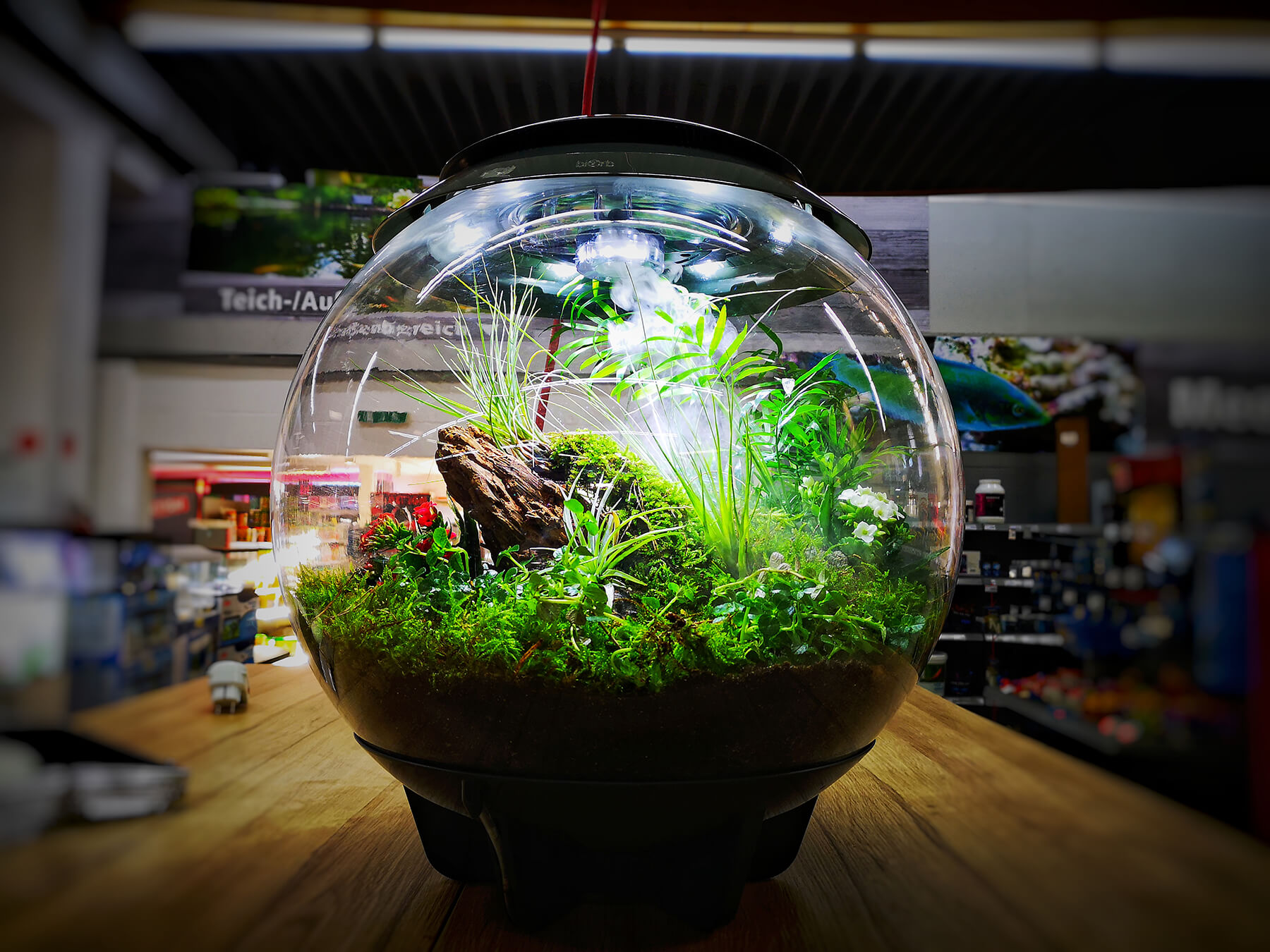
What types of plants are suitable for a hermetosphere?
The choice of plants for a hermetosphere is huge - so we will limit ourselves here to a few particularly well-suited and attractive species, but the range is much, much wider.
Important to know: The hermetosphere has a warm and very humid climate. This is too tropical for most native plants. It is therefore best to grow plants that come from tropical and subtropical, very humid climates, for example from the jungle. By the way, what is used as a side plant in a large hermetosphere can be used to good effect as the main plant in a smaller bottle garden.
And because our main focus is on aquaristics, we have of course paid special attention to plants that we already know well and like from our aquariums. Please note that plants taken from the aquarium are in their underwater form and have to adjust first. The humid climate in a hermetosphere is just perfect for this!
Of course, you will not only find aquarium plants in our list, there are also terrestrial plants that do very well in the humid climate of a bottle garden.
Alternanthera reineckii "mini", the Small Parrot Leaf, is actually a swamp plant, but is better known as an aquarium plant. The upper side of its leaves is dark green to reddish brown, the underside reddish, and the stems are dark red. This makes it a great contrast to green plants in the bottle garden.
Another familiar aquarium plant is Anubias barteri var. nana - the dwarf spear leaf from Africa. This slow-growing, white-flowered marsh plant grows creeping along the ground. It is extremely robust. The rhizome is not buried, but must be exposed to the air. Anubias can also be grown on larger stones. Especially small forms like Anubias barteri var. nana "Bonsai" are super suitable as the main plant for smaller jars.
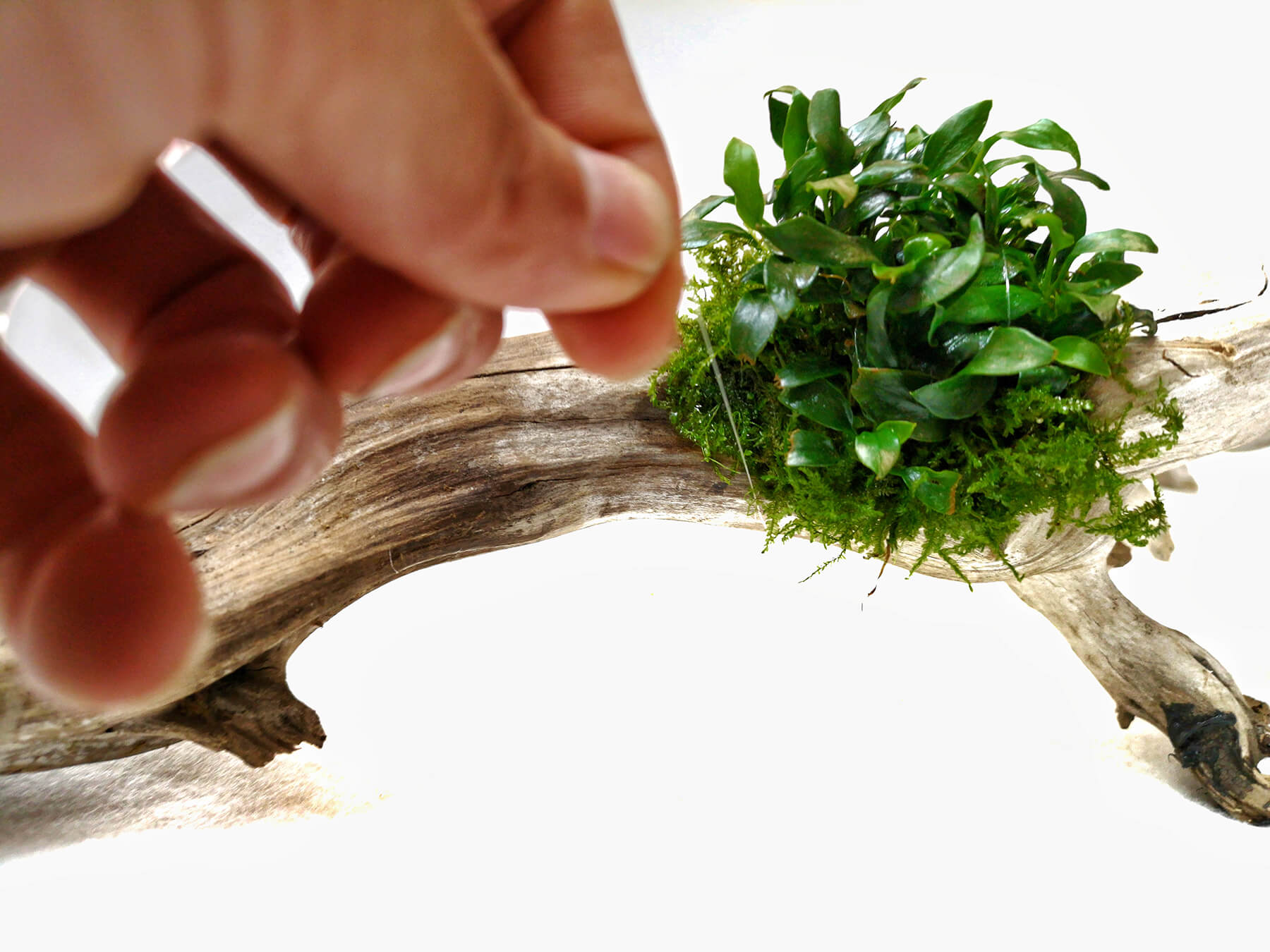
The fine-feathered medium to dark green feather asparagus Asparagus setaceus from Africa looks very good as the main plant. Pruning is recommended from time to time because feather asparagus can grow quite large.
Another familiar aquarium plant is Bacopa monnieri, the small fat leaf. Undemanding, with creeping emersed growth and lilac-white flowers and fleshy light green leaves.
Small bromeliads and tillandsias are ideal for bottle gardens. They always need temperatures above 14°C. Funnel bromeliads do not absorb water through their roots, but through the cisterns they form with their leaves. They need to be refilled with lime-free water from time to time. Bromeliads can be tied up in the hermetosphere or placed in the substrate.
Another well-known aquarium plant: Bucephalandra can also be cultivated perfectly in the hermetosphere. They are not planted, but tied onto stones. The slow-growing epiphytic plants can even flower in the bottle garden. The larger Bucephalandra varieties are great main plants, the smaller ones make great side plants.
Some Cryptocorynes are also great for hermetospheres - Cryptocoryne parva, the dwarf water lily, grows slowly and stays quite small, Cryptocoryne wendtii grows a little taller and is a great main plant for larger jars. Cryptocorynes flower quickly in emersed conditions. They often drop all their leaves first because they have to rearrange themselves. As a precaution, you can also cut them off directly before planting them. As long as the heart of the plant is not damaged, it will sprout again.
Eleocharis acicularis, the needle cress, and Eleocharis sp., the dwarf needle cress, are pretty grass-like marsh plants that also look great in a hermetosphere with their bright green and can form perfect lawns in the bottle garden.
All sorts of members of the Gesneria family are great for hermetospheres - there are lovely flowering plants such as Achimenes grandiflora, the purple-flowered large-flowered slate, the red-flowered pubic flower (Aeschynanthus radicans) or the low-growing white-flowered shade tube (Alsobia dianthiflora as well as Primolina / Chirita tamiana, which is closely related to Usambara violets (which are also very suitable). Also included is Streptocarpus saxorum, the turning fruit or African violet. They are all very suitable for keeping in the bottle garden and make a very pretty picture with their pretty flowers.
Helanthium tenellum, the grass-like dwarf sword plant reproduces via runners and shows light green, delicate, grass-like leaves growing in dense rosettes in the bottle garden. It only grows 5-8 cm high and is therefore ideal as a side plant.
The relatively small rosette plant Eriocaulon cinereum , with its bizarre hedgehog-like structure, is enormously fussy as an aquarium plant, but surprisingly easy to care for when grown emersed in the bottle garden.
Ficus microcarpa (also sold under the names Ficus retusa or Ficus "Ginseng") is not a marsh plant but keeps very well in the bottle garden. The bay fig or Chinese fig grows bonsai-like on thick aerial roots. The small tree copes wonderfully with the conditions in a warm hermetosphere and is a great eye-catcher, especially if you want to create a small landscape in a glass.
There are many great variegated-leaved plants from the genus Fittonia, dark green with white or pink veining, red leaves or bright pink foliage with bronze-coloured veins, to name but a few. Unsuitable as aquarium plants, but in the hermetosphere, fittonias are real stars, providing pretty spots of light and great colour accents. They have no problems in the shade of taller main plants and cope well with less light.
As a ground cover and side plant, the good old aquascaping acquaintance Glossostigma elantinoides, the Australian tongue leaf, is also a star in the bottle garden. It is small, forms a beautiful lawn and grows best in a very moist environment.
Another great carpet plant is Hemianthus callitrichoides "Cuba" or Cuban pearlwort. When grown emersed, tiny white flowers soon appear in the leaf axils. The dwarf pearlwort grows creeping and quickly forms a dense green carpet in the bottle garden.
A pretty addition to a hermetosphere is the pinnate Hygrophila pinnatifida, which can be cultivated in an upright position. The overwater form is medium green and grows upright. The pinnate hygrophila develops flowers in its upper stem nodes.
Lagenandra meeboldii "red" develops a strong rhizome that needs to be placed in the substrate. The ovate leaves are pink when young. The plant grows up to 30 cm high and therefore fits well in larger containers.
Another easy-care grass plant is Lilaeopsis brasiliensis. Especially with a lot of light, it gradually grows into a dense lawn thanks to its daughter shoots.
The dwarf cardinal lobelia Lobelia cardinalis "mini" not only stays pretty small, but can also come into (scarlet) flower. Its leaf colours range from light green to dark green to purple. It needs plenty of light and is quite temperature tolerant when it comes to cold.
The dainty narrow-leaved Ludwigia arcuata from the USA with its pretty reddish to yellowish colours also feels right at home in the hermetosphere. It too can come into flower in the glass, with a flower stalk up to 3.5 cm long on which the yellow flower sits.
Another yellow-flowering plant is the fresh light green Lysimachia nummularia, the pennywort or penny loosestrife, which is even native to our region. The ground cover remains small and can flower yellow. Pennywort is spectacularly hardy and adaptable and does very well in both cool and warmer environments.
Not an aquarium plant for a change: Ophiopogon japonicus minor /nana, the dwarf snakeweed comes more from terraristics or bonsai cultivation, where it is popular as a companion plant. The dark green grass-like leaves are a nice contrast to light green or red plants. The small, inconspicuous panicle flowers can produce very decorative, bright blue berries.
Marsilea hirsuta or Australian clover fern is a beautiful ground cover that can form very different leaf shapes - like a four-leaf clover, divided into two or three parts or simple, similar to Glossostigma. The result is a diverse little meadow in the bottle garden. Young leaves are sometimes brownish in colour when they emerge in bright light.
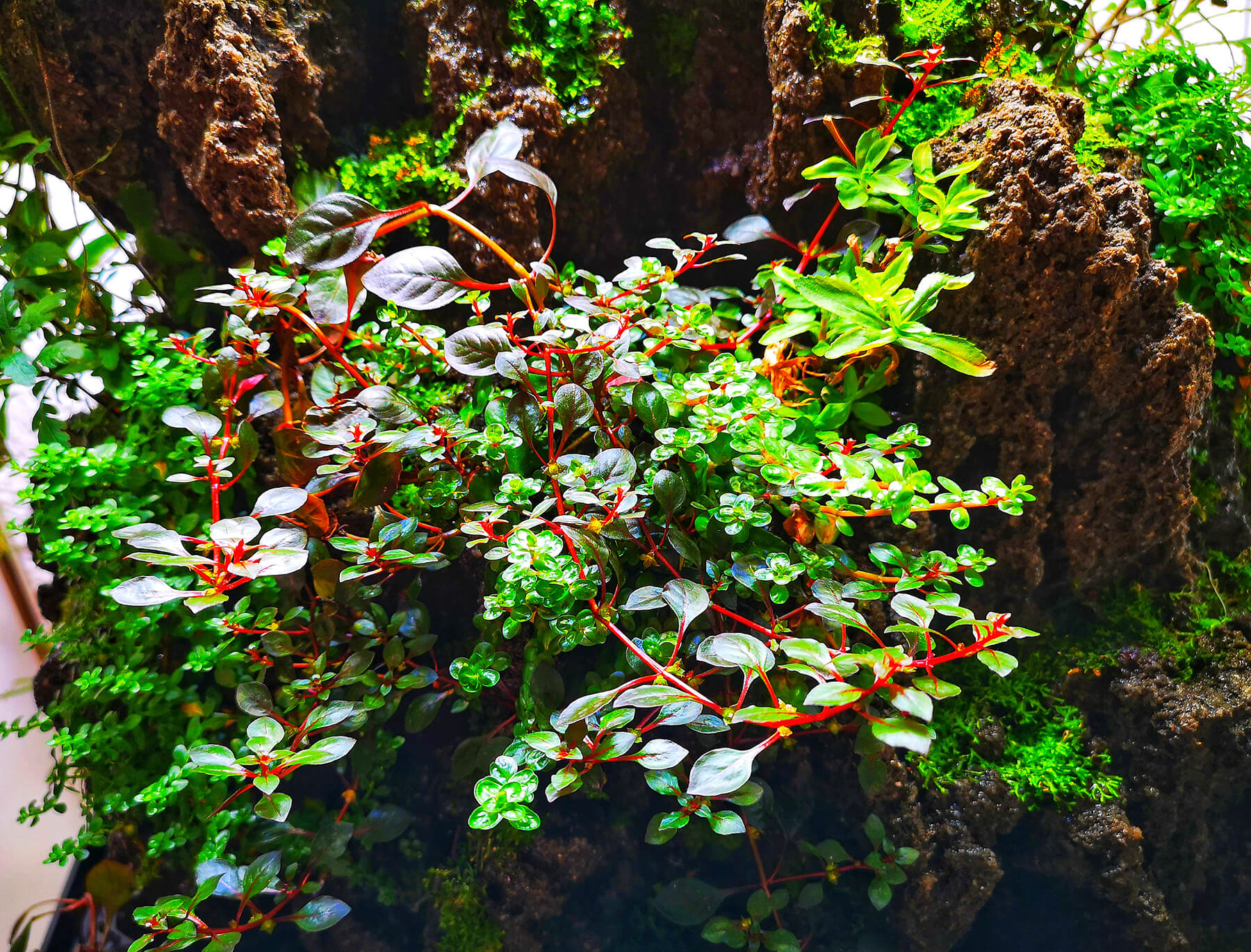
The large genus of peperomia or dwarf pepper is usually known as an indoor plant, but it also feels at home in the bottle garden. Here they have beautifully marked foliage, interesting leaf shapes and beautiful leaf colours. The wrinkled peperomia Peperomia caperata has dark green to reddish leaves that are strikingly wavy and can flower white. Some varieties of Peperomia obtusifolia have yellow or white and green patterned or reddish leaves. They like it a bit warmer, with temperatures from 15 °C you make these dwarf peppers happy. Peperomia rotundifolia looks somewhat different, almost like a stem plant. The overhanging shoots also grow as ground cover, and the light yellow spikes of the flowers look particularly delicate.
The genus Pogostemon, known from aquaristics, is also ideal for bottle gardens: Pogostemon erectus with its fine leaves and purple flowers is just as attractive a plant for hermetospheres as the well-known Pogostemon helferi with its star-shaped light green leaf rosette.
The very well-known aquarium plant Rotala indica or Indian Rotala forms emersed rather slow-growing prostrate stems that develop small reddish flowers in the leaf axils of the short side branches and on the stem. It needs quite a lot of light and then has dark green-reddish foliage.
A little more difficult to keep in the aquarium, but a great carpet plant in emersed conditions is Utricularia graminifolia, the grass-leaved water hose from tropical Asia. The water hose forms a dense carpet that grows to a maximum height of 4 cm. The light green leaves grow on lying shoots. Although it is a carnivorous plant like all water hoses, Utricularia graminifolia does not depend on this food. The fine light purple flowers sit on thin stems and are pretty eye-catchers in the bottle garden.
Actually a bonsai: Zanthoxylum piperitum, the pepper tree or Szechuan pepper, is easy to care for and robust. It does well in a bottle garden and has no problems with high humidity. The glossy green leaflets and the tree shape make the pepper tree a great eye-catcher for larger hermetospheres. Every now and then new shoots need to be pruned into shape.
Ferns
The classic water ferns that we know from aquaristics also look great in bottle gardens. Here, a dwarf form for smaller hermetospheres stands out: Bolbitis heterclita "difformis", the Mini-Bolbitis or Tailed Dwarf Water Fern, which forms a pretty carpet. Microsorum pteropus "Windelov", Windelov's java fern, which only grows about 15 cm high, also fits nicely into smaller plant jars, while other java fern cultivars do well in larger bottle gardens. A case for large hermetospheres is Bolbitis heudelotii, the African water fern, which is dark bottle green and looks very primal and original with its fronds.
Mosses
Our aquarium mosses are also suitable for the bottom vegetation of bottle gardens. Many mosses are ideally suited for emerse cultivation. We have presented the species in detail in this article: Successfully cultivating mosses in aquariums and terrariums". All species that are suitable for the terrarium can also be used in the bottle garden.
The most popular species are Java moss (Taxiphyllum barbieri), Singapore moss (Vesicularia dubyana), Christmas moss (Vesicularia montagnei) with its striking triangular fronds, and the overhanging Weeping moss (Vesicularia ferriei), which can be cultivated in the bottle garden hanging down from stone structures.
But you can also find liverworts with their somewhat broader, smooth fronds: The delicate pond liver wort Monosolenium tenerum is ideal for planting on stones, as is Mini Pellia or coral moss (Riccardia chamedryfolia). Especially the latter moss grows very filigree and compact, it sticks nicely to the stones. Coral moss likes it a little cooler than the other moss species and should not be kept permanently warmer than 27 °C.
